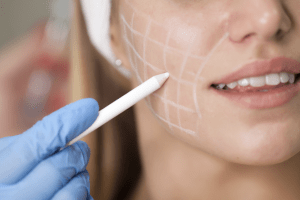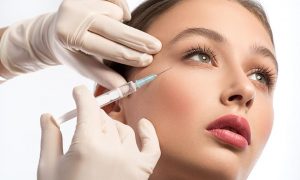Fillers in Dubai | Dr Matteo Vigo
The use of injectable facial fillers is one of the fastest growing areas in the field of cosmetic surgery. Many advances in have been made in the last 5 years that have led to safer, more predictable and longer lasting fillers.
As one ages, the face loses volume. This creates more prominent wrinkles and skin folds while features become less distinct. Dynamic wrinkles caused by facial movement such as smiling and frowning appear. Injectables were designed to subtly reduce these signs of aging.
Most fillers work by restoring the volume of a part of the face. Or filling the lip or wrinkle and are gradually digested by the body. Hyaluronic Acid Fillers: These were the first of the new fillers to be FDA approved. Hyaluronic acid is a naturally occurring carbohydrate which occurs in skin. It is a clear gel with a thick consistency. Since skin testing is not required, injections may be done on the same day as the initial consultation. Manufacturers have manipulated particle size (thickness) and crosslinked molecules to offer both normal and longer duration products.
Juviderm and Teosyal
Juviderm and Teosyal are examples of normal duration products. These are injected in more superficial lines and have easier flow characteristics. Juvederm Voluma and Teosyal Redensity II are examples of longer duration products are usually injected into deeper lines and folds.
The newest advance has been the addition of local anesthetic, Lidocaine, to the filler to reduce discomfort upon injection.
Guide to Dermal Fillers for Facial Rejuvenation
Guide to the Types of Dermal Fillers
Everything You Ever Wanted To Know About Lip Injections
Dr. Matteo Vigo is a member of the International Society of Aesthetic Plastic Surgery (ISAPS) is the world’s leading professional body for board-certified aesthetic plastic surgeons. Fillers in Dubai.
Although no one likes the thought of aging, we can be thankful that we are living in this modern age. When there are more facial cosmetic procedures than ever before to aid in the battle against time. Injectable fillers are not only effective, they are a completely safe method of rejuvenating the face.
Even in the past 10 years, there have been advancements in the science of fillers, and my clinic offers several different approved brands. The most popular are Juvéderm, Profhilo, Restylane, Radiesse, Teosyal and Neauvia. The area of the face that requires filling determines the type of filler that he chooses. Some fillers have a thicker consistency than others and are more suited to areas where more substance is needed to achieve the desired lift. It is possible to fill nasolabial folds (lines between the nose and mouth), cheekbones, noses, chins, tear troughs, jowls, and lips.

Fillers in Dubai
FILLERS IN DUBAI: CONTOURING AND REFINING FEATURES
When injected by an experienced professional, fillers also have the ability to contour and refine features. Lips can be augmented to reduce the lines that appear with aging, and small noses can be enlarged so that they balance nicely with other facial features. A flat chin can be injected with filler to provide a symmetrical profile.
Fillers can provide a straighter nose for people who have a hump in the middle. Cheek bones can be injected to provide a natural-looking lift to the face. Although amazing results can be achieved with injectable fillers, it is the artist in control of the needle who determines the final outcome. It takes artistry, not just a licence, to sculpt the face in perfect harmony and proportions.
Not only can fillers be injected in a short period of time, but there is also little discomfort for the patient. Local anaesthetic is administered prior to the injections, and some brands even have the anaesthetic combined with the filler. Slight swelling or redness at the injection site may be experienced, but this is minimal, eliminating the need to take a few days off of work to heal. Another major benefit of injectable fillers is that they are affordable. Great results can be accomplished without breaking your pocket book.
THINGS TO KNOW IF YOU’RE CONSIDERING DERMAL FILLERS
Whether you are considering getting dermal fillers to smooth out wrinkles or enhance facial contours, a quick look at some criteria and facts will help you know you have come to the right place for your treatment.
Dermal fillers should be injected only by an experienced and qualified medical doctor. This procedure requires qualifications, experience, and an artistic edge, because 90% of the success of cosmetic procedures depends on who is doing them. For example, a bad haircut would indicate the level of experience of the stylist, not the scissors that were used.
This is why it is extremely important to inquire about the credentials of your practitioner and ask to see before and after pictures. Getting a consultation first is advisable, as you would get a chance to see my facility and raise your questions or concerns with me.
FILLERS IN DUBAI: YOUR EXPECTATIONS
Bringing a picture of your younger self to your appointment is helpful. However, bringing a picture of your favorite celebrity is not conducive. While you may see one aspect or feature of your face, it is important to know that a face has to be analysed in whole and not in part.
The aim of the injectable procedure is to look naturally enhanced. It is also important to understand that each face has its own asymmetry. A good doctor can help bring more symmetry while keeping the overall aesthetics of the face visually pleasing. So make the most of your consultation by being open to recommendations. Your doctor sees in three dimensions, and you would benefit from exploring all your options.
THE ACTUAL PRODUCT
There are many types of dermal fillers on the market. But the most common of them are hyaluronic acid (HA) products. They have proven to produce natural and lasting results while maintaining fluidity to move with facial expressions. This line of dermal fillers also incorporates antioxidants, minerals, and vitamins to deliver further treatment benefits while filling and contouring the face.

fillers in dubai
HOW LONG THE RESULTS WILL LAST
Hyaluronic acid in dermal fillers also naturally occurs in the body and therefore gets metabolized eventually. Depending on the dermal filler chosen and whether or not this is the first time you are having a filler injected, you can expect results to last anywhere from 3 to 6 months. If for some reason you are not satisfied with the results, which is very rare, HA fillers are also dissolvable at your request by injecting an enzyme called hyaluronidase.
FILLERS IN DUBAI: WHAT TO DO BEFORE AND AFTER THE INJECTION
It is always best to schedule your injectable appointments a couple of days to a week prior to any major event. With dermal filler injections, you will also need to take bruising and swelling into account. You can reduce this likelihood by stopping any supplements that can act like blood thinners such as fish oil and also some pain killers such as Aspirin, Aleve, Advil, etc., 2 weeks prior to your appointment.
After your dermal fillers treatment, follow the post-care instructions given, which include applying cold compresses, avoiding extremely cold or hot drinks, sun exposure, extreme temperatures, excess facial mimicry, and vigorous exercises. Being gentle is key.
Who is a Candidate?
- Facial fillers are administered over a wide age range.
- Younger patients seeking fuller, plumper lips or cheeks
- Older patients seeking volume restoration, wrinkle reduction and fuller lips.
- Men who wish reduction of folds and volume restoration to look younger.
Intended Results
- Redefinition of the volumes in the face
- Fuller and plumper lips.
- Softening of superficial and deep wrinkles.
- Softening of wrinkles which appear during facial movement (smiling, frowning, concentrating and looking surprised).
Procedure Description
- This procedure is usually performed in the office.
- Most surgeons use a topical anesthetic cream and also administer local anesthetic injections prior to injecting fillers.
- Ice may be applied before and after injection.
- Immediate swelling may create the appearance of over treatment – this swelling generally resolves in several hours.
Recuperation and healing
- For most patients, fillers can be injected in the lips or wrinkles and they can return to work the same day. It is considered a lunch treatment
- Occasionally a patient swells more than expected, especially in the lips. A first time patient may want to schedule the initial injection on a day close to the weekend.
- It is a good idea not to schedule filler injection right before an important social function.
Note
Fillers in Dubai – The specific risks and the suitability of this procedure for a given individual can be determined only at the time of consultation with your cosmetic surgeon. Minor complications that do not affect the outcome occur occasionally. Major complications are rare.
[ratings]
